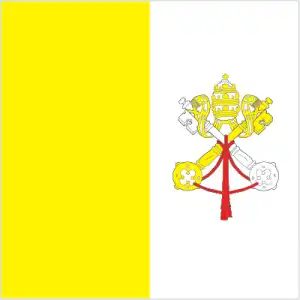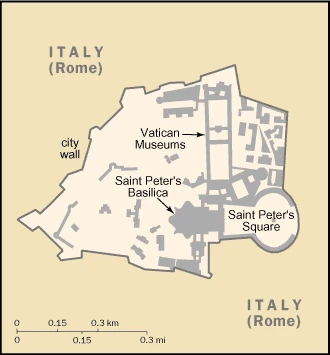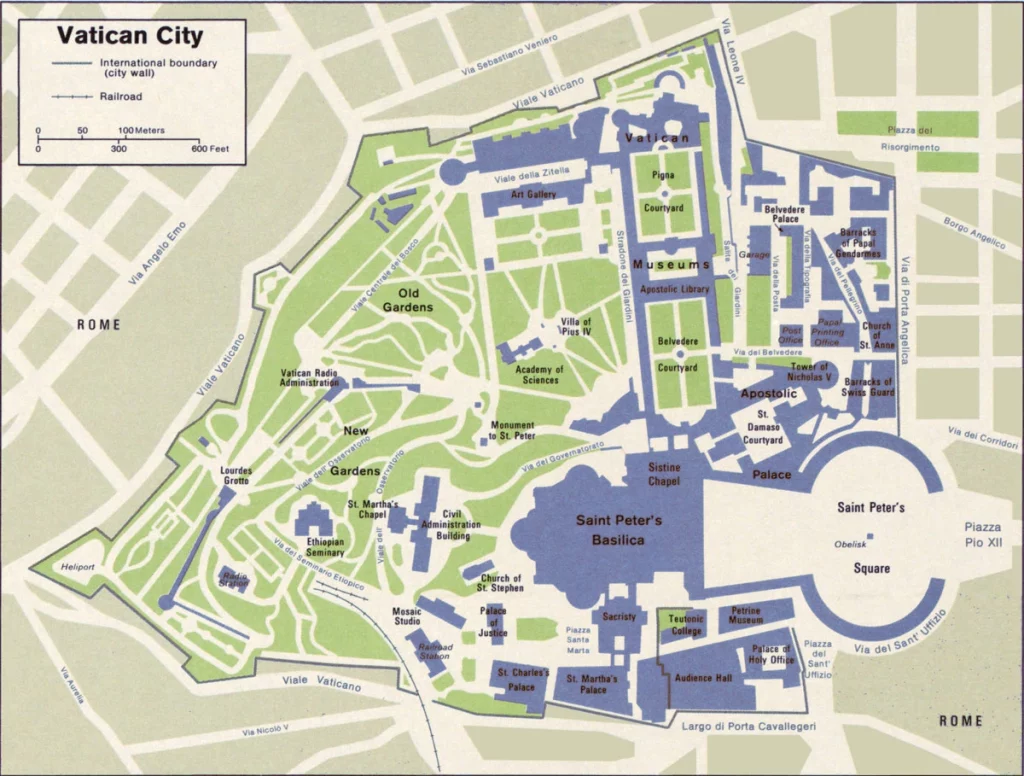Vatican City Google Maps is a site/tool that offers a wide range of map views (topographic, satellite, street view) and navigation options, with little effort on your part, yet efficiently. If you need to plan a trip to a new place like Vatican City, Google maps are available on desktop, mobile, or tablet. This Google maps and information page is dedicated to Vatican City, Europe (47 countries), showing its location, country facts, details about its capital city Vatican City, bordering countries like Italy, and plenty of other information which may be interesting when you visit this European state.
Quick links: Google maps Vatican City, Vatican City Google maps, Driving Directions Vatican City, Printable Road Map.

About Vatican City in a nutshell
- Conventional short form of the name: Holy See (Vatican City)
- The conventional long form of the name: The Holy See (Vatican City State)
- Local long form: La Santa Sede (Stato della Citta del Vaticano)
- Local short form: Santa Sede (Citta del Vaticano)
- Former name(s): N/A
- Etymology: holy comes from the Greek word hera meaning sacred; see comes from the Latin word sedes meaning seat, and refers to the episcopal chair; the term Vatican derives from the hill Mons Vaticanus on which the Vatican is located and which comes from the Latin vaticinari (to prophesy), referring to the fortune tellers and soothsayers who frequented the area in Roman times.
- The legal system in Vatican City: religious legal system based on canon (religious) law.
- Climate: Mild winters with regular rainfall. Hot, dry summers with occasional thunderstorms.
- The national symbols are crossed keys beneath a papal tiara; national colors: yellow, white.
- Internet TLD: .va
The city-state on the western edge of Rome, on the right bank of the Tevere, is the only state on Earth with its entire territory a UNESCO World Heritage Site. Its center is St Peter’s Cathedral, the largest church in the world. Built on an early Christian basilica site, it stands 132 meters tall, and its Michelangelo-designed dome is a symbol of Rome. Inside, 60,000 people at a time can admire the magnificent frescoes, sculptures, and papal tombs. A colonnade of 246 columns encloses the elliptical St Peter’s Square in front of the basilica. The eleven Vatican Museums, with their five galleries and 1,400 rooms, are also a unique treasure trove of the finest works by the world’s greatest painters.
The Vatican City is the spiritual center for one in six of the worlds population.
Background
Popes in their secular role ruled portions of the Italian peninsula for more than a thousand years until the mid-19th century, when many of the Papal States were seized by the newly united Kingdom of Italy. In 1870, the Pope’s holdings were further circumscribed when Rome itself was annexed. Disputes between a series of prisoner popes and Italy were resolved in 1929 by three Lateran Treaties, which established the independent state of Vatican City and granted Roman Catholicism special status in Italy. In 1984, a concordat between the Holy See and Italy modified certain of the earlier treaty provisions, including the importance of Roman Catholicism as the Italian state religion. Present concerns of the Holy See include religious freedom, threats against minority Christian communities in Africa and the Middle East, the plight of refugees and migrants, sexual misconduct by clergy, international development, interreligious dialogue and reconciliation, and the application of church doctrine in an era of rapid change and globalization. About 1.3 billion people worldwide profess Catholicism – the world’s most enormous Christian faith.
Geography
The Vaticans territory includes 10 other buildings in Rome, plus the papal residence. The Vatican Gardens cover half the Citys area.

The Vatican City, or Holy See, the seat of the Roman Catholic Church, is a walled enclave in the Italian City of Rome. It is the worlds smallest fully independent state.
This state is located in Southern Europe, an enclave of Rome (Italy), under the coordinates of 41 54 N, 12 27 E, covering an area of 0 sq km with a coastline of 0 km (landlocked country). Vatican City is About 0.7 times the size of the national mall in Washington, DC.
Vatican City has 3.4 km of land boundaries and borders (1 nation): Italy has 3.4 km.
Urban, low hill, with Vatican gardens (Vatican hill) 78 m as the highest point of Vatican City, while Saint Peters Square 19 m as the lowest point. With a total of 0 sq km, Vatican City has 0.44 sq km of land and 0 sq km of water surface area.
Landlocked; an enclave in Rome, Italy; the world’s smallest state; beyond the territorial boundary of Vatican City, the Lateran Treaty of 1929 grants the Holy See extraterritorial authority over 23 sites in Rome and five outside of Rome, including the Pontifical Palace at Castel Gandolfo (the Pope’s summer residence)
The climate in Vatican City is as follows: Temperate, mild, rainy winters (September to May) with hot, dry summers (May to September).
The natural hazards of visiting Vatican City shall be considered: Occasional earthquakes.
The following major health-threatening issues shall be considered when visiting Vatican City: none.
Current environmental issues affecting the people: some air pollution from the surrounding City of Rome.
Google maps Vatican City
The capital and other divisions
Capital city: Vatican City found under the coordinates 41 54 N, 12 27 E, applying the time zone UTC+1 (6 hours ahead of Washington, DC, during Standard Time), using the following daylight saving time: +1hr begins last Sunday in March; ends last Sunday in October.
Vatican City is the smallest country globally, but it’s home to over 100 UNESCO World Heritage Sites buildings. The most famous of these are St Peter’s Basilica and the Sistine Chapel, known for their distinct Gothic and Renaissance styles. The Vatican is located within Rome, so it’s only a 15-minute walk to St. Peter’s Basilica.
Vatican City became independent on 11 February 1929, and its national holiday is Election Day of Pope FRANCIS, 13 March (2013).
Administrative divisions: none.
People and society
The Vatican has about 800 permanent inhabitants, including over 100 laypersons. Thousands of lay staff are also employed. Citizenship can be acquired through the long-term residence and holding a position within the City. The reigning Pope has supreme legislative and judicial powers and holds office. Though the Vatican City is officially neutral, papal opinion significantly influences the worlds 1.2 billion Roman Catholics.
The population in Vatican City is 1,000 (2019 estimate), with an average of 0% (2014 estimate) change. That means Vatican City is the No. 235 in the world’s populated rank list.
The people living in this country are the None (noun) or none (adjective) and belong mainly to the following ethnic groups: Italian, Swiss, Argentinian, and other nationalities from around the world (2017).
They speak Italian, Latin, French, and various other languages and practice the following religions: Roman Catholic.
Industry
Investments and voluntary contributions made by Catholics worldwide (known as Peters Pence) are backed up by tourist revenue and the issue of Vatican stamps and coins.
The Holy See is supported financially by various sources, including investments, real estate income, and donations from Catholic individuals, dioceses, and institutions; these help fund the Roman Curia (Vatican bureaucracy), diplomatic missions, and media outlets. Moreover, an annual collection taken up in dioceses and from direct donations goes to a non-budgetary fund, known as Peters Pence, which is used directly by the Pope for charity, disaster relief, and aid to churches in developing nations., The separate Vatican City State budget includes the Vatican museums and post office. It is supported financially by selling stamps, coins, medals, tourist souvenirs, and fees for admission to museums and publication sales. Revenues increased between 2010 and 2011 because of expanded operating hours and a growing number of visitors. However, the Holy See did not escape the financial difficulties experienced by other European countries; in 2012, it started a spending review to determine where to cut costs to reverse its 2011 budget deficit of $20 million.
The Holy See generated a modest surplus in 2012 before recording a $32 million deficit in 2013, driven primarily by the decreasing value of gold. The incomes and living standards of lay workers are comparable to those of counterparts who work in the City of Rome, so most public expenditures go to wages and other personnel costs. In February 2014, Pope FRANCIS created the Secretariat of the Economic to oversee the Holy See’s financial and administrative operations as part of a broader campaign to reform the Holy Sees finances.
The main industrial sectors are typically printing, production of coins, medals, postage stamps, mosaics, staff uniforms, worldwide banking, and financial activities.
Vatican City Driving Directions
In this post, you learned about Vatican City, Southern Europe, an enclave of Rome (Italy). We published some basic information about its capital Vatican City, and the none nation.
Are you interested in visiting Vatican City and looking for driving directions? Click here to plan your route, or see a printable road map of Vatican City below for an overview of the route network.
Printable map of Vatican City
Did you know about Vatican City?
Vatican City is an independent country with a population of just 900. Vatican City’s territory is just 110 acres, but it houses the most sacred shrines in the world. The Pope presides over the Roman Catholic church and has complete jurisdiction over all Catholics in this country, even though he does not have any political power.
Whether you want to find out more information about the Vatican or if you are interested in (or going to) Rome, a tour of this City will give insight into this fascinating City. There’s a lot to see, but here are some of the highlights:
- The Basilica of St. Peter is the imposing church that sits at the center of Vatican City
- The Vatican Museums are filled with amazing paintings and sculptures from around the world, including Michelangelo’s famous Pietà-Saint Peter’s Square is one of Rome’s most recognizable landmarks and is home to Bernini’s famous “Fountains,” as well as beautiful fountains throughout the square
- Castel Sant’Angelo was commissioned by Emperor Hadrian in 135 AD, and it was completed by his successor Antoninus Pius, making it one of the oldest buildings in Rome.
After virtually visiting Vatican City, you may also be interested in the neighboring country: Italy.
If you liked our Google map and Vatican City information page,
please share it with others or save the link https://www.drivingdirections.net in your bookmarks.

